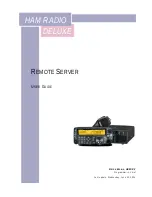
High Performance Ethernet Modes:
Your Ethernet controllers support optional
modes, such as teaming, priority packets, and virtual LANs, which provide higher
performance and throughput for your computer.
Teaming Mode:
Your Ethernet controllers provide options, called
teaming options
.
These options increase throughput and fault tolerance when running with
Windows NT 4.0 and Windows 2000.
v
Adapter fault tolerance
(AFT) provides automatic redundancy for your adapter.
If the primary adapter fails, the secondary adapter takes over. Adapter fault
tolerance supports from 2 to 4 adapters per team.
v
Adaptive load balancing
(ALB) enables you to balance the transmission data
flow among 2 to 4 adapters. ALB also includes the AFT option. You can use ALB
with any 100BASE-TX switch.
v
Cisco Fast EtherChannel
(FEC) creates a team of 2 to 4 adapters to increase
transmission and reception throughput. FEC also includes the AFT option. You
can only use FEC with a switch that has FEC capability.
Teaming requires you to install both integrated Ethernet controllers. For additional
information about the teaming modes, refer to the documentation that comes with
these additional adapters.
Priority Packet Mode:
Priority Packet is a traffic-prioritization utility that enables
you to set up filters to process high-priority traffic before normal traffic. You can
send information from critical nodes or applications with an indicated priority.
Because you set this priority at the host or entry point of the network, the network
devices can base forwarding decisions on priority information defined in the
packet.
Priority Packet information is available on the IBM Networking Web site at:
http://www.ibm.com/networking/support
Priority Packet prioritizes traffic based on priority filters. These are parameters you
assign to outgoing (transmit) packets. Using the Priority Filter Wizard, you can set
up predefined or custom priority filters based on a node (MAC) address, Ethernet
type, or by various properties of the protocol and port. Priority Packet provides
two different methods for prioritizing traffic: IEEE 802.1p tagging and High
Priority Queue.
IEEE 802.1p is a new IEEE standard for tagging, or adding additional bytes of
information to packets with different priority levels. Packets are tagged with 4
additional bytes, which increase the packet size and indicate a priority level. When
you send these packets out on the network, the higher priority packets are
transferred first. Priority packet tagging (also known as Traffic Class Expediting)
allows the adapter to work with other elements of the network (such as switches
and routers) to deliver priority packets first. You can assign specific priority levels
from 0 (low) to 7 (high).
You can assign values to packets based on their priority when you use the IEEE
802.1p standard for packet tagging. This method requires a network infrastructure
that supports packet tagging. The routing devices receiving and transferring these
packets on your network must support 802.1p for tagging to be effective.
After you set up the priority filter in Priority Packet, you must launch PROSet and
select
802.1p/802.1Q Tagging
on the Advanced tab.
Installing options
99
Summary of Contents for 867413x - Eserver xSeries 330 8674
Page 2: ......
Page 93: ...Installing memory modules Complete the following steps to install a DIMM Installing options 85...
Page 165: ...Related service information 157...
Page 167: ...Related service information 159...
Page 169: ...Related service information 161...
Page 171: ...Related service information 163...
Page 183: ...Related service information 175...
Page 191: ......
Page 192: ...Part Number 24P2923 1P P N 24P2923...
















































